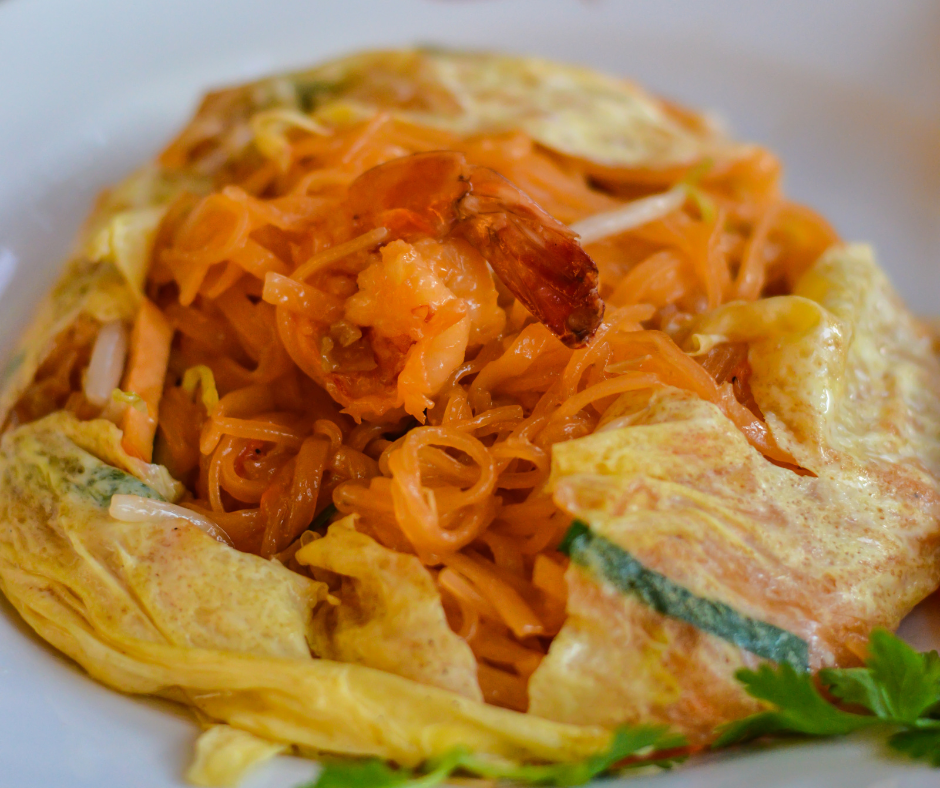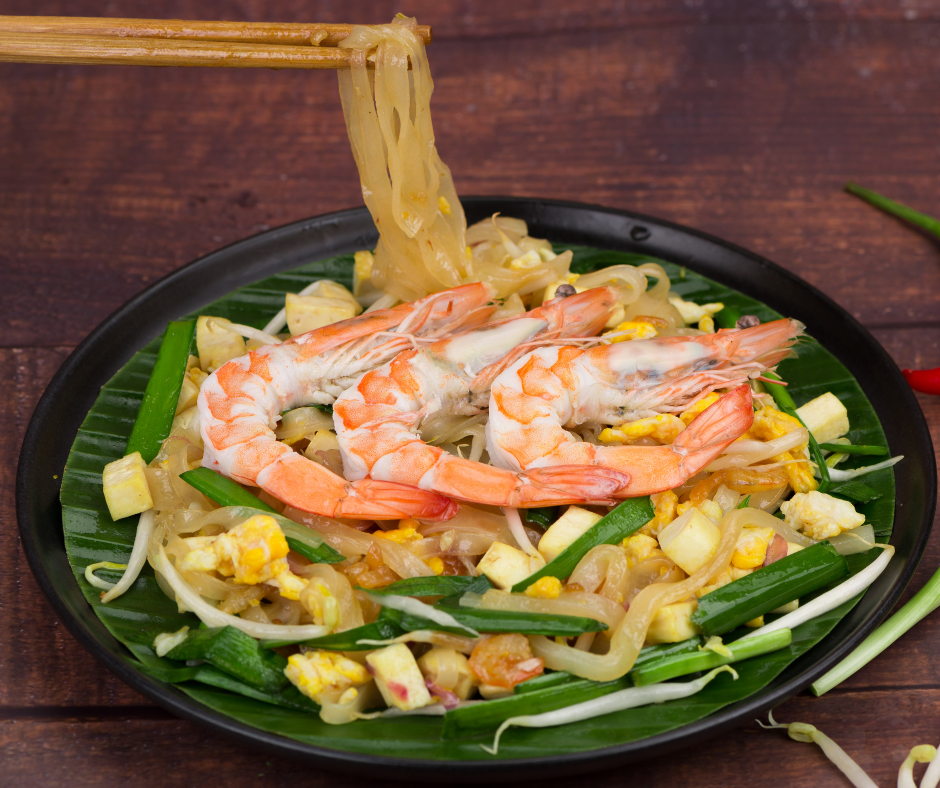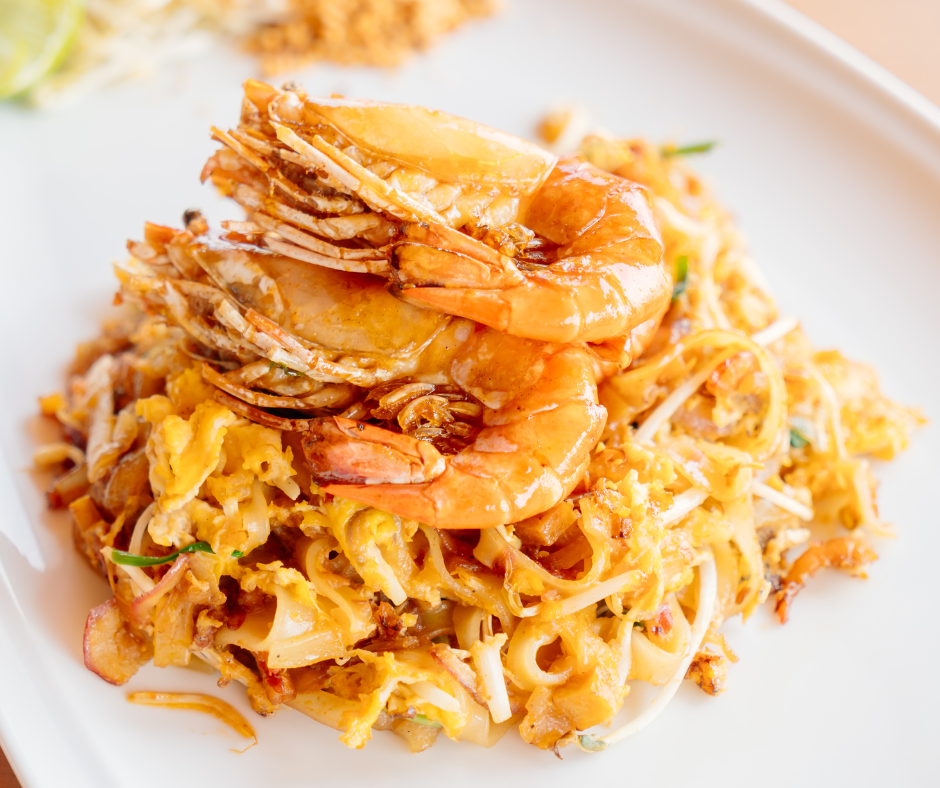Introduction
Pad Thai is a beloved and iconic Thai dish that has gained international recognition and popularity. If you have ever wondered about ‘Where Is Pad Thai From?‘, you have come to the right place!
What Is Pad Thai?
Pad Thai is a stir-fried dish with rice noodles, eggs, tofu, shrimp or chicken, bean sprouts, peanuts, and a tangy sauce. Pad Thai balances sweet, sour, and savory notes, flavored with tamarind paste, fish sauce, garlic, and shallots. Over the years, various adaptations and regional variations of this dish have emerged, but the essential ingredients and flavors remain the same.
The Popularity Of Pad Thai Worldwide
Pad Thai’s popularity has transcended Thailand’s borders and become a global sensation. This can be attributed to several factors:
Cultural fusion: The flavors and textures of Pad Thai appeal to a wide range of palates. It combines sourness from tamarind, sweetness from palm sugar, and umami from fish sauce, creating a harmonious blend of flavors.
Accessibility: The availability of key ingredients and the ease of preparation have contributed to Pad Thai’s popularity. Many Thai restaurants worldwide include Pad Thai on their menus, making it accessible to people from different cultural backgrounds.
Tourism impact: As Thailand became a popular tourist destination, visitors loved the local cuisine, including Pad Thai. They brought their newfound appreciation back to their home countries, leading to increased demand and the establishment of Thai restaurants abroad.
Adaptation and globalization: Pad Thai has been adapted and customized to suit local tastes in different parts of the world. For example, vegetarian or vegan versions are available to cater to dietary preferences. This adaptability has contributed to its widespread popularity.
While it is difficult to trace the exact origins of Pad Thai, it is believed to have emerged during the 1940s in Thailand. The dish gained popularity as part of a government campaign to promote Thai identity and unify the country. Since then, it has become synonymous with Thai cuisine and a symbol of Thai culinary culture.
Whether you enjoy Pad Thai at a local Thai restaurant or try making it at home, this iconic dish continues to bring joy and satisfaction to food lovers worldwide. So, next time you indulge in a plate of Pad Thai, you’ll know more about its rich history and global influence.
Note: If you want more information or ready-made recipes, refer to the Pad Thai page on Wikipedia.
Where Is Pad Thai From Origins And Influences?
The Traced Origins Of Pad Thai
Pad Thai is a renowned Thai dish that has gained immense popularity across the globe. While the exact origin of this flavorful noodle dish remains debated, its history can be traced back to the early 20th century during Thailand’s nationalistic efforts to modernize and define its national cuisine.
One theory suggests that Pad Thai was created as part of a campaign by the Thai government to promote nationalism and encourage the consumption of rice noodles. The government aimed to reduce rice consumption due to an economic crisis. As a result, rice noodles were promoted as a patriotic alternative.
Another theory points to the influence of Chinese traders who immigrated to Thailand. It is believed that Chinese stir-fried noodle dishes, such as Hokkien mee, inspired Pad Thai. Over time, Thai cooks adapted these flavors and techniques to suit local tastes, creating a distinct Thai version.
The Influence Of Chinese Cuisine
Chinese influence on Thai cuisine has been significant, and Pad Thai is no exception. Chinese traders brought cooking techniques, ingredients, and flavors that greatly influenced the development of Thai cuisine.
The use of stir-frying, noodles, and soy sauce in Pad Thai can be attributed to Chinese culinary traditions. These elements were seamlessly incorporated into Thai cuisine, resulting in the beloved dish we know today.
While Thai cuisine has evolved and developed its unique flavors and techniques, it maintains a strong connection to its Chinese roots. Pad Thai is a prime example of the blending of cultures and culinary influences that have shaped Thai cuisine over the centuries.
In conclusion, Pad Thai has its roots in Thailand’s efforts to define its national cuisine and promote rice noodles. It owes its distinctive taste and preparation techniques to the influence of Chinese culinary traditions brought by Chinese immigrants. Today, Pad Thai has become an iconic Thai dish enjoyed by people worldwide, showcasing the rich fusion of flavors and cultural influences that make Thai cuisine unique and delicious.
Pad Thai During World War II
Pad Thai has become one of the most iconic dishes of Thai cuisine, loved and enjoyed by people worldwide. But have you ever wondered ‘Where Is Pad Thai From?’ Let’s journey back in time to uncover the story behind the creation of Pad Thai.
Pad Thai As A Cheap And Filling Option
During World War II in the 1940s, Thailand faced a rice shortage due to government policies and the impact of the war. To overcome this challenge, the Thai government promoted the consumption of noodles as an alternative to rice. Noodles were cheap, filling, and readily available, making them a practical choice for a nation facing scarcity.
Noodles And Ingredients During The Shortage
At that time, Pad Thai was known as “Pad Thai Thamada” or “fried Thai noodles.” It was created to make the most out of the limited resources. Rice noodles were stir-fried with whatever ingredients were available, such as tofu, shrimp, or chicken. A mixture of tamarind paste, fish sauce, sugar, and spices was used to add flavor. These ingredients offered a unique combination of sweet, savory, and tangy flavors and helped preserve the food.
Pad Thai quickly became popular nationwide, providing a delicious and satisfying meal that everyone could enjoy. Street food vendors embraced this dish and started selling it on the streets of Thailand, where it gained even more popularity.
Today, Pad Thai has evolved with various regional and international versions, but the essence of this humble dish remains the same. It continues to be a beloved staple of Thai cuisine and is widely enjoyed in restaurants worldwide.
In conclusion, Pad Thai originated during World War II in Thailand as a creative solution to the rice shortage. Its affordability, versatility, and delicious taste made it a popular choice among the Thai people. Today, Pad Thai stands as a testament to the ingenuity and resourcefulness of the Thai culture and remains a favorite dish for locals and international food lovers.
The Components Of Pad Thai
Stir-fried Rice Noodles And Vegetables
Pad Thai is a popular dish with stir-fried rice noodles and various vegetables. The noodles are typically thin and flat, creating a soft and chewy texture. Common vegetables used in Pad Thai include bean sprouts, green onions, and carrots, though variations can include other veggies like bell peppers, cabbage, or mushrooms. This combination of noodles and vegetables provides a satisfying and nutritious base for the dish.
Tamarind Sauce, Fish, Shrimp, And Other Ingredients
The key to Pad Thai’s unique and tangy flavor comes from its signature sauce. Tamarind sauce, made from tamarind pulp mixed with water, sugar, fish sauce, and other seasonings, gives Pad Thai its distinct sweet and savory taste. The sauce is then added to the stir-fried noodles and vegetables, creating a flavorful coating that binds the ingredients together.
While the exact origin of Pad Thai is debated, it is widely believed to have been influenced by Chinese and Vietnamese cuisine. Its origins can be traced back to the Ayutthaya period in Thai history, around the 17th century. During this time, Thailand had close trading relations with China, leading to the introduction of stir-frying techniques and noodles to the Thai culinary scene.
Over time, Pad Thai evolved to incorporate unique Thai flavors and ingredients. Adding fish sauce, shrimp, tofu, and ground peanuts became essential elements in the dish. These ingredients provide protein, umami flavors, and a satisfying crunch, enhancing the overall taste and texture of Pad Thai.
Pad Thai gained popularity within Thailand during the World War II era when the government promoted it as a national dish to foster a sense of Thai nationalism. Promoting Pad Thai led to its widespread recognition as a symbol of Thai cuisine worldwide.
Today, Pad Thai can be found in Thai restaurants around the globe, ranging from street food stalls to upscale dining establishments. Its popularity is due to its harmonious blend of flavors, vibrant presentation, and versatility – it can be customized with additional ingredients such as chicken or tofu to suit different dietary preferences.
In conclusion, Pad Thai is a beloved Thai dish that showcases the marriage of Chinese stir-frying techniques with Thai ingredients and flavors. Its origins can be traced back to the Ayutthaya period, and it has since become one of Thailand’s most famous culinary exports. Whether enjoyed on the bustling streets of Bangkok or in the comfort of your kitchen, Pad Thai offers a delicious taste of Thai cuisine.
Variations And Street Food Culture
Vegetarian And Regional Variations
Pad Thai is a versatile dish that can be customized to suit different preferences and dietary restrictions. Vegetarian versions of Pad Thai are popular, with tofu or vegetables replacing the meat. The dish also has regional variations that incorporate local ingredients and flavors. For instance, in northern Thailand, Pad Thai is often prepared with crispy rice noodles and is slightly sweet. In the south, it may feature seafood or fish sauce for a more savory taste. These variations highlight the adaptability of Pad Thai as a dish that can be enjoyed in different ways throughout Thailand and beyond.
Pad Thai As A Signature Bangkok Street Food
When visiting Bangkok, one cannot miss the bustling street food stalls that offer a wide array of delicious dishes. Pad Thai is undoubtedly one of Bangkok’s street food scene stars. Its quick preparation and affordable price make it popular among locals and tourists. Watching a skilled street vendor expertly stir-fried noodles in a sizzling wok with spices filling the air is an experience that encapsulates the essence of Thai culinary culture.
The origins of Pad Thai can be traced back to the 1940s when the Thai government, under Prime Minister Plaek Phibunsongkhram, sought to promote nationalism and unity by introducing a national dish. Inspired by the Chinese stir-fried noodles, Pad Thai was created using local ingredients such as rice noodles, eggs, tofu, dried shrimp, and tamarind sauce. This fusion of flavors and textures resulted in a dish quickly becoming a staple in Thai cuisine and gaining popularity worldwide.
Despite its Chinese influences, Pad Thai has developed its unique Thai identity over the years, adding Thai spices, fresh herbs, and the balance of sweet, salty, and sour flavors that Thai cuisine is known for. Today, it is enjoyed in restaurants and street stalls around the globe, with each region adding its twist to the traditional recipe.
In conclusion, Pad Thai is a beloved Thai dish that has captured people’s hearts and taste buds worldwide. Its versatility, adaptability, and rich history make it a cultural icon in Thailand and a must-try dish for anyone seeking to explore Thai cuisine.
FAQ: Where Is Pad Thai From? Tracing the Origins of This Iconic Thai Dish
Q: What is the origin of Pad Thai?
A: Pad Thai, which is now recognized as one of Thailand’s most famous dishes worldwide, did not actually originate in Thailand. Its roots can be traced back to the 1930s, when it was introduced as part of the country’s cuisine.
Q: Was Pad Thai always a part of Thai cuisine?
A: No, Pad Thai was not always a part of Thailand’s culinary tradition. It gained popularity and became widely known within the country in the 1930s, but prior to that, fried noodles were not strongly associated with Thai cuisine.
Q: Who introduced Pad Thai to Thailand?
A: It is believed that Pad Thai was introduced to Thailand during the time of Field Marshal Plaek Phibunsongkhram, commonly known as Phibun. Phibun, who was the Prime Minister of Thailand in the 1930s, promoted the dish as a part of his nationalistic agenda to modernize the country.
Q: Did Pad Thai originate from Chinese cooks?
A: Some historians suggest that Pad Thai may have originated from Chinese cooks. In fact, its original name, “kway teow pad thai,” means Thai-style stir-fried noodles in Chinese. It is interesting to note that a Thai chef naming a dish with a Chinese term raises questions about its true origin.
Q: Is Pad Thai considered an authentic Thai dish?
A: The authenticity of Pad Thai is a subject of debate. While it may not meet the strict standards of traditional Thai cuisine, there are plenty of people in Thailand who defend its Thai bona fides and consider it a beloved part of their culinary culture.
Q: Is Pad Thai the national dish of Thailand?
A: Pad Thai is not officially recognized as the national dish of Thailand. However, it is widely consumed throughout the country and has gained international recognition as a symbol of Thai cuisine.
Q: How would you describe the global influence on Pad Thai?
A: Pad Thai’s popularity has spread beyond Thailand and gained a global following. Its use of various ingredients from around the world does not detract from its Thai identity. In fact, it showcases how cuisine can evolve and embrace global flavors while still retaining its cultural roots.
Q: Can Pad Thai be found in restaurants outside of Thailand?
A: Yes, Pad Thai is readily available in Thai restaurants worldwide. Its widespread popularity has made it a staple on the menus of many establishments catering to lovers of Thai cuisine.
Q: Are there regional variations of Pad Thai?
A: While Pad Thai is generally consistent in its basic ingredients, there may be regional variations that incorporate local flavors and techniques. Different regions of Thailand may add their own unique twist to the dish, resulting in subtle differences in taste and presentation.
Q: Is Pad Thai a vegetarian-friendly dish?
A: Pad Thai can be made with or without meat, making it a versatile dish that can accommodate dietary preferences. Vegetarian or vegan versions often substitute meat with tofu or additional vegetables, ensuring that it remains accessible to individuals with different dietary choices.
Conclusion
Now you should know the answer to ‘Where Is Pad Thai From?’. Pad Thai, the iconic Thai dish, has captured people’s hearts and taste buds worldwide. Its unique combination of flavors, textures, and aromas has made it a favorite among Thai cuisine lovers. From humble beginnings on the streets of Thailand to being celebrated in high-end restaurants, Pad Thai has become a culinary sensation.
The Everlasting Popularity Of Pad Thai
Pad Thai’s popularity spans continents and generations. Its delicious blend of stir-fried rice noodles, shrimp or chicken, tofu, eggs, bean sprouts, and peanuts, combined with the tangy flavors of tamarind sauce, fish sauce, and lime, creates a harmonious medley of flavors. This timeless dish continues to delight people of all ages and backgrounds.
The Cultural Significance And Global Reach Of Pad Thai
Beyond its exquisite taste, Pad Thai holds significant cultural meaning. It represents the fusion of Thai flavors and culinary traditions. With its origins dating back to the 1930s during a nationwide campaign to promote nationalism, Pad Thai has become a symbol of Thai identity and pride.
Over the years, Pad Thai has expanded its reach beyond Thailand’s borders, thanks to globalization and the increasing popularity of Thai cuisine worldwide. Today, you can find Pad Thai on menus in restaurants across the globe, from New York to London to Sydney. Its versatility and adaptability to different dietary preferences have contributed to its success in the international culinary scene.
This beloved dish has brought joy to people’s palates worldwide and brought people together. When enjoying Pad Thai, one can experience a sense of connection to Thai culture and its rich culinary heritage.
In conclusion, Pad Thai continues to reign as a beloved dish, captivating taste buds and representing Thai culture globally. Its unique flavors, cultural significance, and adaptability have made it a staple in countless restaurants and homes worldwide. Whether dining in Thailand or experiencing Thai cuisine in your kitchen, Pad Thai is a timeless classic that will never disappoint.



